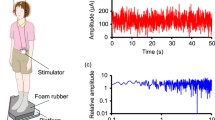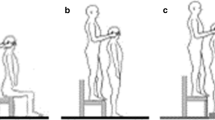Abstract
Patients with bilateral vestibular loss have difficulty maintaining balance without stepping when standing in tandem, on compliant surfaces, across narrow beams, or on one foot, especially with eyes closed. Normal individuals (with no sensory impairment) maintain balance in these tasks by employing quick, active hip rotation (a “hip strategy”). The absence of a hip strategy in vestibular patients responding to translations of a short support surface has previously been taken as evidence that the use of hip strategy requires an intact vestibular system. However, many tasks requiring hip strategy alter one or a combination of important system characteristics, such as initial state of the body (tandem stance), dynamics (compliant surfaces), or biomechanical limits of stability (narrow beams). Therefore, the balance deficit in these tasks may result from a failure to account for these support surface alterations when planning and executing sensorimotor responses. In this study, we tested the hypothesis that vestibular information is critical to trigger a hip strategy even on an unaltered support surface, which imposes no changes on the system characteristics. We recorded the postural responses of vestibular patients and control subjects with eyes closed to rearward support surface translations of varying velocity, in erect stance on a firm, flat surface. Subjects were instructed to maintain balance without stepping, if possible. Faster translation velocities (25 cm/s or more) produced a consistent pattern of early hip torque (first 400 ms) in control subjects (i.e., a hip strategy). Most of the patients with bilateral vestibular loss responded to the same translation velocities with similar torques. Contrary to our hypothesis, we conclude that vestibular function is not necessary to trigger a hip strategy. We postulate, therefore, that the balance deficit previously observed in vestibular patients during postural tasks that elicit a hip strategy may have been due to the sensorimotor consequences of the system alterations imposed by the postural tasks used in those studies. Preliminary results from two younger patients who lost vestibular function as infants indicate that age, duration of vestibular loss, and/or the timing of the loss may also be factors that can influence the use of hip strategy as a rapid postural response.
Similar content being viewed by others
Author information
Authors and Affiliations
Additional information
Received: 20 February 1997 / Accepted: 30 April 1998
Rights and permissions
About this article
Cite this article
Runge, C., Shupert, C., Horak, F. et al. Role of vestibular information in initiation of rapid postural responses. Exp Brain Res 122, 403–412 (1998). https://doi.org/10.1007/s002210050528
Issue Date:
DOI: https://doi.org/10.1007/s002210050528




